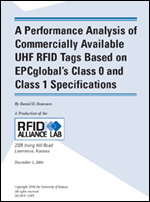The RFID Alliance Lab, a not-for-profit test center, today released a comprehensive report on the performance of 10 commercially available UHF RFID tags based on EPCglobal’s Class 1 and Class 0 specifications. The tags were tested in free air, near metal and water, and on products traveling on a conveyor in an operational warehouse.
“This is the first scientific analysis of the performance of these tags,” says Daniel Deavours, the lab’s research director. “The results enable end users to determine which tags are likely to perform best on their products.”
The aim of the lab was not to choose the best tag but to enable end users to compare the performance of the tags in free air, near different product types and under real-world conditions. Not surprisingly, no one tag performed best under all conditions.
The Symbol Technology (formerly Matrics) dual-dipole tag (model number X2040) was best near metal. The Rafsec 457 tag did well near water, and the Symbol single-dipole I2010, Alien M and Avery Dennison single-dipole Strip (U1014) tags were read at the greatest distance in free air.
Deavours and his team spent 1,350 hours conducting more than 5,000 tests. Conditions in the lab were scientifically controlled to ensure that differences in performance were a result of the tags’ design and not external factors. (For complete details on how the tags were tested, see How the Lab Tests Were Conducted.)
The lab measured each tag’s radiation pattern, and the results are charted in the report to enable end users to see how the tags reflect RF energy. This will enable end users to determine each tag’s “orientation sensitivity”—that is, how much the tag’s ability to be read is affected by its orientation to the reader antenna.
Free-air tests give end users information about how the tags perform on “RF-friendly” products and can also be used as a baseline to compare the performance of tags when placed near conductors, such as metal cans, and near dielectrics (nonconductors), such as products with high water content.
The conveyor tests were the least scientific because the conditions in the warehouse could not be controlled. The tests were done in a warehouse owned by a major manufacturing company, and the company’s operations continued while the tests were conducted. But the data from the tests of tags on products traveling on a conveyor give an indication of how the tags would perform on real products in the real world.
“This is the kind of information end users and systems integrators have never had before,” says Toby Rush, president of Rush Tracking Systems, a Kansas City-area systems integrator that serves as an advisor to the Alliance Lab. “Many companies are trying to do their own tests, but these tests are not scientific. As a result, companies are wasting a lot of time putting different tags on products and testing them through trial and error. The lab’s data takes the guesswork out of choosing tags.”
The RFID Alliance Lab was created by the University of Kansas’s Information and Telecommunication Technology Center (ITTC), RFID Journal and Rush Tracking Systems to provide objective, scientific testing of RFID products. The first lab report can be purchased through the RFID Journal Web site (www.rfidjournal.com/labreports) for $995 for a single report or $3,495 for a one-year subscription, which includes four reports. RFID Journal subscribers receive a 10 percent discount when purchasing a single report or a subscription.


